ORZC13
| Location: Birchip. | Australian Soil Classification: Epihypersodic, Pedal, Calcic CALCAROSOL. |
| Geology: Quaternary (Woorinen Formation). | General Landscape Description: Level plain. |
| Site Description: Pasture. | Native Vegetation: Mallee (with Casuarina). |
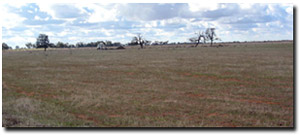 Site ORZC13 Landscape |
Soil Profile Morphology:
Surface Soil
| Ap | 0-10 cm | Dark reddish brown (5YR3/3); clay loam; hardsetting surface condition; moderate coarse to medium blocky structure; strong consistence (dry); slightly calcareous; pH 7.3; clear change to: | 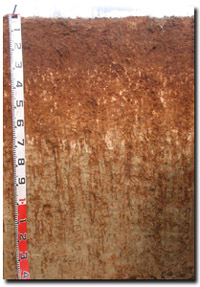 Site ORZC13 Profile |
| Subsoil | |||
| B21 | 10-30 cm | Dusky red (2.5YR3/4); light medium clay; strong medium to fine sub-angular blocky structure; very firm consistence (dry); slightly calcareous; pH 8.5; clear change to: | |
| B22k | 30-65 cm | Yellowish red (5YR5/8); light clay; moderate-strong coarse to medium blocky structure; fine earth carbonate segregations common (15%) with few (2-5%) hard root channel carbonate and fine nodules; strong consistence (dry); highly calcareous; pH 8.9; clear change to: | |
| B23 | 65-110 cm | Very pale brown (10YR7/3) with yellowish red (5YR5/8) mottles and root channel infills; light clay; moderate coarse prismatic, parting to moderate coarse to medium blocky structure; very few hard to semi-hard calcium carbonate nodules; moderately calcareous; pH 9.1; gradual change to: | |
| B24 | 110+ cm | Very pale brown (10YR7/3) with yellowish red (5YR5/8) mottles and root channel infills; light clay; moderately calcareous; pH 9.0. | |
Key Profile Features:
- Gradual increase in texture (clay content) with depth.
- Calcium carbonate segregations in upper subsoil.
pH | Salinity Rating | |||
Surface soil (Ap horizon) | Slightly Alkaline | Low | Sodic | Moderate 1 |
Upper subsoil 10 - 30 cm | Moderately Alkaline | Very High | Strongly Sodic | None 1 |
Deeper subsoil (at 65-110 cm) | Very Strongly Alkaline | Very High | Strongly Sodic | None 2 |
Deep subsoil (at 110+ cm) | Strongly Alkaline | Very High | Strongly Sodic | None 2 |
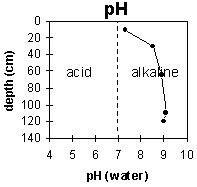 | 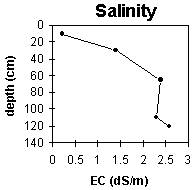 | 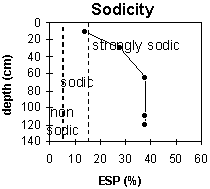 |
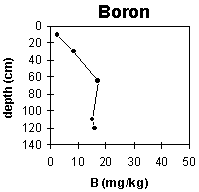 | 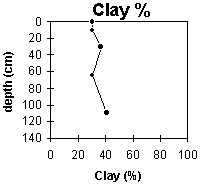 |
Horizon | Horizon Depth (cm) | pH (water) | pH (CaCl2) | EC 1:5 | NaCI % | Exchangeable Cations | Boron mg/kg | Field Capacity pF 2.5 | Wilting Point pF 4.2 | Coarse Sand (0.2 - 2.0 mm) | Fine Sand (0.02 -0.2 mm) | Silt (0.002 -0.02 mm) | Clay (<0.002 mm) | |||
Ca | Mg | K | Na | |||||||||||||
meq/100g | ||||||||||||||||
Ap | 0-10 | 7.3 | 6.5 | 0.22 | 7.5 | 5.7 | 1.6 | 2.4 | 2.5 | 23 | 11 | 28 | 32 | 6 | 31 | |
B21 | 10-30 | 8.5 | 7.9 | 1.4 | 0.3 | 11 | 12 | 1.8 | 9.6 | 8.5 | 47 | 25 | 12 | 14 | 33 | 37 |
B22k | 30-65 | 8.9 | 8.5 | 2.4 | 0.49 | 7.3 | 13 | 1.4 | 13 | 17 | 50 | 25 | 10 | 17 | 32 | 31 |
B23 | 65-110 | 9.1 | 8.6 | 2.3 | 0.49 | 6.9 | 13 | 1.5 | 13 | 15 | 49 | 23 | 12 | 13 | 16 | 41 |
B24 | 110+ | 9 | 8.6 | 2.6 | 0.53 | 7.3 | 14 | 1.5 | 14 | 16 | ||||||
General
- Management strategies for all soils should aim to increase organic matter levels in the surface soil; minimise the degradation of soil aggregates and porosity; promote the development of stable biopores; improve the calcium status of the cation exchange complex (particularly when sodium is a significant part), and break up any hardpans. Less frequent tillage; using less aggressive implements, and working the soil at optimum moisture content can all assist in maintaining soil aggregation and porosity as well as reducing the breakdown of organic matter.
- The hardsetting surface horizon disperses in water (strongly after remoulding). This indicates that dispersion may occur if the soil is tilled in a moist to wet condition. Also, raindrop action on bare surface soil may also promote dispersion and result in surface sealing or surface crust formation. Surface cover should be maintained as much as possible to protect against raindrop damage. The use of gypsum may also assist in ameliorating the surface soil condition.
- Increasing organic matter levels will assist in improving surface soil aggregation and ameliorating the hardsetting condition. Organic matter levels will decline under cropping, but can be improved by adopting practices such as minimum tillage, residue retention, and utilising pasture rotations.
- The subsoil has very high levels of soluble salts, which will significantly restrict the growth of non salt-tolerant species (e.g. faba beans, linseed, chick peas, lupins). Plant Available Water Capacity will also be reduced for all plants.
- The subsoil is also strongly sodic throughout but does not disperse due to the high level of soluble salts. The uppermost subsoil horizon (10-30 cm), although strongly sodic, does have reasonable structure (parting strongly to fine sub-angular blocky). This should promote good root growth – apart from any deleterious effects of the soluble salts. The deeper subsoil (from 30 cm depth), however, becomes more dense and coarsely structured.
- Boron toxicity is likely to occur in strongly alkaline soils. The boron levels measured in the deeper very strongly alkaline subsoil (i.e. at 30 cm depth) are reasonably high (i.e. >15 mg/kg) and may affect boron-sensitive species (including cereals, pulses, pasture legumes). Concentrations as low as 10 ppm, for example, can reduce lentil yield. Limited data estimates that the threshold for level of soluble boron for cereals is 15 mg/kg (Cartwright et al., 1984). Other work at VIDA indicates that where there are low levels of soluble salts, that boron tolerance can be comparatively high, with little reduction in wheat yield at levels of up to 45 ppm (Quinlan, 2001).
References
Cartwright, B., Zarcinas, B.A, and Mayfield, A.H. (1984). Toxic Concentrations of Boron in a Red-Brown Earth at Gladstone, South Australia. Australian Journal of Soil Research. 22. 261-72.
Hobson, K. (2001). Boron Tolerant Lentils. In On The Pulse pamphlet. NRE. 2001.
Maschmedt, D. (2000). Agricultural Land Classification Standards Used in South Australia’s Land Resource Mapping Program. Department of Primary Industries, South Australia.
Quinlan, J. (2001). Sorting out the Boron Problem. Wimmera Farming & Landcare Newsletter. 19-20.
Rengasamy, P. and Churchman, G.J. (1999). Cation Exchange Capacity, Exchangeable Cations and Sodicity. In: Soil Analysis – An Interpretation Manual. (eds. Peverill, K.I et al). CSIRO Publishing.
White, P.F. (1990). Soil and Plant Factors Relating to the Poor Growth of Lupinus species on Fine Textured Soils – A Review. Australian Journal of Agricultural Research, 41: 871-890.


